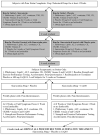A randomized trial of coenzyme Q10 in patients with confirmed statin myopathy
- PMID: 25545331
- PMCID: PMC4298455
- DOI: 10.1016/j.atherosclerosis.2014.12.016
A randomized trial of coenzyme Q10 in patients with confirmed statin myopathy
Abstract
Background: Coenzyme Q10 (CoQ10) supplementation is the most popular therapy for statin myalgia among both physicians and patients despite limited and conflicting evidence of its efficacy.
Objective: This study examined the effect of coenzyme Q10 (CoQ10) supplementation on simvastatin-associated muscle pain, muscle strength and aerobic performance in patients with confirmed statin myalgia.
Methods: Statin myalgia was confirmed in 120 patients with prior symptoms of statin myalgia using an 8-week randomized, double-blind crossover trial of simvastatin 20 mg/d and placebo. Forty-one subjects developed muscle pain with simvastatin but not with placebo and were randomized to simvastatin 20 mg/d combined with CoQ10 (600 mg/d ubiquinol) or placebo for 8 weeks. Muscle pain (Brief Pain Inventory [BPI]), time to pain onset, arm and leg muscle strength, and maximal oxygen uptake (VO2max) were measured before and after each treatment.
Results: Serum CoQ10 increased from 1.3 ± 0.4 to 5.2 ± 2.3 mcg/mL with simvastatin and CoQ10, but did not increase with simvastatin and placebo (1.3 ± 0.3 to 0.8 ± 0.2) (p < 0.05). BPI pain severity and interference scores increased with simvastatin therapy (both p < 0.01), irrespective of CoQ10 assignment (p = 0.53 and 0.56). There were no changes in muscle strength or VO2max with simvastatin with or without CoQ10 (all p > 0.10). Marginally more subjects reported pain with CoQ10 (14 of 20 vs 7 of 18; p = 0.05). There was no difference in time to pain onset in the CoQ10 (3.0 ± 2.0 weeks) vs. placebo (2.4 ± 2.1 wks) groups (p = 0.55). A similar lack of CoQ10 effect was observed in 24 subjects who were then crossed over to the alternative treatment.
Conclusions: Only 36% of patients complaining of statin myalgia develop symptoms during a randomized, double-blind crossover of statin vs placebo. CoQ10 supplementation does not reduce muscle pain in patients with statin myalgia. Trial RegistrationNCT01140308; www.clinicaltrials.gov.
Keywords: Aerobic performance; CoQ10; Exercise; Muscle pain; Muscle strength; Myalgia; Statin; Ubiquinol.
Copyright © 2014 Elsevier Ireland Ltd. All rights reserved.
Conflict of interest statement
Figures


Comment in
-
Statin myopathy: a problem looking for a solution.Atherosclerosis. 2015 Mar;239(1):85-6. doi: 10.1016/j.atherosclerosis.2014.12.054. Epub 2015 Jan 3. Atherosclerosis. 2015. PMID: 25576849 No abstract available.
References
-
- MRC/BHF Heart Protection Study of cholesterol lowering with simvastatin in 20,536 high-risk individuals: a randomised placebo-controlled trial. Lancet. 2002;360:7–22. - PubMed
-
- Phillips PS, Haas RH, Bannykh S, et al. Statin-associated myopathy with normal creatine kinase levels. Ann Intern Med. 2002;137:581–5. - PubMed
-
- Bruckert E, Hayem G, Dejager S, Yau C, Begaud B. Mild to moderate muscular symptoms with high-dosage statin therapy in hyperlipidemic patients--the PRIMO study. Cardiovasc Drugs Ther. 2005;19:403–14. - PubMed
-
- Marcoff L, Thompson PD. The role of coenzyme Q10 in statin-associated myopathy: a systematic review. J Am Coll Cardiol. 2007;49:2231–7. - PubMed
Publication types
MeSH terms
Substances
Associated data
Grants and funding
LinkOut - more resources
Full Text Sources
Other Literature Sources
Medical

